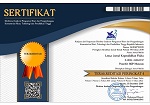Ethnophysical Analysis of Sigale-Gale Statue Performance as Physics Learning Resources
DOI:
https://doi.org/10.33394/j-lkf.v13i1.16129Keywords:
Ethnophysics, Local wisdom, Physics learning, Sigale-gale, Qualitative analysisAbstract
Physics learning is often perceived as challenging by students due to the abundance of formulas and abstract theories, as well as the lack of contextual learning resources. One approach that can be implemented to enhance students' interest and understanding is integrating local wisdom into physics learning through ethnophysics. This study aims to identify physics concepts in the Sigale-Gale puppet performance in North Sumatra and to analyze how the ethnophysical approach can be utilized to create more contextual and meaningful learning experiences. This research serves as an initial study of North Sumatran cultural performances in the context of physics. The method used is qualitative, in the form of a literature review. The results indicate that the Sigale-Gale performance encompasses various physics concepts, such as sound waves produced by gondang musical instruments, and the principles of motion, levers, balance, and acceleration embedded in the puppet’s mechanism. By applying the ethnophysical approach, students can gain a more tangible understanding of physics while also helping to preserve local culture. These findings can serve as a foundation for developing lesson plans (RPP) based on local culture, making physics learning more enjoyable, interactive, and meaningful.
References
Astuti, I., & Bhakti, Y. (2021). Kajian etnofisika pada Tari Piring sebagai media pembelajaran fisika. Sinasis, 2(1), 477–482.
Astuti, I. A. D., Sumarni, R. A., Setiadi, I., & Zahra, R. A. (2022). Kajian etnofisika pada Tari Soya-soya sebagai sumber ajar fisika. Orbita: Jurnal Pendidikan dan Ilmu Fisika, 8(2), 333–338.
Elisa, et al. (2023). Konsep gelombang dan penerapannya dalam kehidupan. Banda Aceh: Syiah Kuala University Press.
Fadli, M., Insani, A. K., Delima, K., & Mahfud, T. A. R. (2022). Kajian mekanika pada materi pesawat sederhana: Review publikasi ilmiah. Mitra Pilar: Jurnal Pendidikan, Inovasi, dan Terapan Teknologi, 1(2), 171–190.
Hidaayatullaah, H. N., Suprapto, N., Hariyono, E., Prahani, B. K., & Wulandari, D. (2021, November). Research trends on ethnoscience-based learning through bibliometric analysis: Contributed to physics learning. In Journal of Physics: Conference Series (Vol. 2110, No. 1, p. 012026). IOP Publishing.
Karyasa, T. B. (2011). Dasar-dasar getaran mekanis. Yogyakarta: CV Andi.
Magdalena, et al. (2021). Metode penelitian. Bengkulu: IAIN Padangsidimpuan Press.
Meidayanti, I., Anggraeni, A., Aldo, & Kurniawati, W. (2023). Memahami jenis-jenis dari pesawat sederhana serta analisis manfaatnya bagi banyak orang. Jurnal Pengabdian Masyarakat Indonesia, 1(2), 290–298.
Nasution, S. W. R., Nasution, H. N., & Nasution, U. S. Z. (2024). Kajian etnofisika materi gerak pada Tari Tortor di Tapanuli Selatan dalam pembelajaran fisika. Jurnal Education and Development, 12(3), 359–362.
Nopriantoko, R. (2022). Buku mekanika. Jakarta: CV Jejak.
Nurcahyani, D., Rahmayanti, H., Ichsan, I. Z., & Rahman, M. M. (2021, February). Ethnoscience learning on science literacy of physics material to support environment: A meta-analysis research. In Journal of Physics: Conference Series (Vol. 1796, No. 1, p. 012094). IOP Publishing.
Nurroniah, Z., Sani, S., Wulandari, R., Cahya, N., Kusumaningtyas, S. K. S., & Nuraini, L. (2023). Pengembangan augmented learning berbasis etnosains Tari Lahbako untuk literasi sains dan minat pada konsep gerak melingkar. Edusains, 15(2), 164–175.
Rianna, M., & Sembiring, T. (2022). Buku ajar fisika dasar 1. CV Merdeka Kreasi Group.
Rusianto, T., & Susastriawan, A. A. P. (2021). Getaran mekanis. Yogyakarta: Akprind Press.
Sihombing, N., Kasmahidayat, Y., & Sunaryo, A. (2022). Tari Tor-Tor Patung Sigale-Gale. Ringkang, 2(1), 154–163.
Sihombing, N., et al. (2022). Tari Tor-Tor Patung Sigale-Gale. Ringkang, 2(1), 154–163.
Sihotang, S. M., Purnomo, B., & Meihan, A. M. (2023). Tari Patung Sigale-Gale sebagai wisata budaya di Pulau Samosir Sumatera Utara. Krinok, 2(3), 136–146.
Simanihuruk, B. (2024). Kajian ekologi sastra dalam cerita rakyat “Sigalegale†(The study of literary ecology in “Sigalegale†folklore). Sanggam, 1(1), 1–9.
Sumarni, R. A., Setiadi, I., Astuti, I. A. D., Suhaya, M. E., & Zahra, R. A. (2023). Analisis etnofisika pada Tari Siloloa sebagai sumber pembelajaran fisika. Sinasis, 4(1), 116–122.
Sumarni, R., et al. (2023). Analisis etnofisika pada Taro Siloloa sebagai sumber pembelajaran fisika. Sinasis, 4(1), 116–122.
Wijaya, R. C. (2022). Mekanika gelombang laut dan sungai. Bandar Lampung: Pusaka Media.
Wilyanti, V., Yulya, T., Febriyani, T., & Rahmadani, S. (2023, May). Development of Articulate Storyline 3 learning media based on local wisdom in traditional Lampung games in improving science skills. In 4th International Conference on Progressive Education 2022 (ICOPE 2022) (pp. 756–766). Atlantis Press.
Yuberti. (2014). Konsep materi fisika dasar 2. Bandar Lampung: Anugrah Utama Raharja (AURA).
Downloads
Published
How to Cite
Issue
Section
License
Authors who publish with Lensa: Jurnal Kependidikan Fisika agree to the following terms:
- For all articles published in Lensa: Jurnal Kependidikan Fisika, copyright is retained by the authors. Authors give permission to the publisher to announce the work with conditions. When the manuscript is accepted for publication, the authors agree to automatic transfer of the publishing right to the publisher.
- Authors retain copyright and grant the journal right of first publication with the work simultaneously licensed under a Creative Commons Attribution-ShareAlike 4.0 International License that allows others to share the work with an acknowledgment of the work's authorship and initial publication in this journal.
- Authors are able to enter into separate, additional contractual arrangements for the non-exclusive distribution of the journal's published version of the work (e.g., post it to an institutional repository or publish it in a book), with an acknowledgment of its initial publication in this journal.
- Authors are permitted and encouraged to post their work online (e.g., in institutional repositories or on their website) prior to and during the submission process, as it can lead to productive exchanges, as well as earlier and greater citation of published work (See The Effect of Open Access).

This work is licensed under a Creative Commons Attribution-ShareAlike 4.0 International License.



